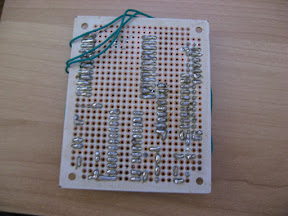Here's another interesting method of perfboarding, this guy does it with SMD components and really tiny wires. He made a special little wiring pen for laying down the wires:
Progressive Wiring Techniques

(source: davr.org)
Personally I make solder bridges for pins that are in adjacent holes, for things further away I use thin wires (though not as thin as the ones above) in adjacent holes to the things I want to connect.
Top of my board:

Bottom of my board:

And no, I didn't just wire those pins all on the fly, I had drawn up a detailed schematic in advance. There's no way I could keep track of so many wires just in my head.
The wave only contacts the bottom side of the PCB.
Once upon a time, a wave solder machine was used to solder SMT parts on the bottom side of the PCB but this is not used as much anymore in favor of more modern techniques.
Here is the rough process for soldering PCB's with SMT parts on both sides, and through hole (TH) parts on the top side only.
A. The bare PCB is turned "bottom side up". A solder paste is pressed through a stencil and onto the pads of the PCB. A pick and place machine places the parts onto the bottom side. The PCB is ran through an oven (hot-air convection or an IR oven) to melt the solder and attach the parts.
An optional step is to place a small drop of glue under the parts. Solder paste first, then glue, then the parts are put onto the PCB and soldered. This glue helps keep the parts from falling off during a later step.
B. The board is turned over (top side up), and the same process is repeated for all SMT parts on the top side of the PCB. By that I mean solder paste, parts placed, then through the oven. No glue is needed.
During step B, the parts on the bottom of the PCB don't fall off. Obviously if they are glued down then they are stuck there, but most companies do not use glue. Without glue, the surface tension from the molten solder is enough to hold the parts in place. Some parts, particularly heavy parts without many pins, might not work with this technique since there is not enough surface tension to hold the parts on.
C. All of the through-hole parts are then placed on the top side of the PCB. A solder pallet is attached to the bottom of the PCB. The PCB is ran through a wave solder machine to solder all the TH parts.
Note: A solder pallet is basically a shield to protect the SMT parts from being removed in the wave. They are custom made for each PCB, and have holes and contours to expose the TH parts while shielding the SMT parts. The PCB must be designed with the solder pallet in mind, since you can't place the bottom side SMT parts too close to the TH parts and the SMT parts cannot be too tall.
A relatively new technique for TH parts is to skip the wave solder machine completely. Back in step B, solder paste is placed on the TH pads (and in the holes) and the TH parts are inserted and soldered in the oven with the rest of the SMT parts. Some companies, like Motorola, have gotten rid of their wave solder machines in favor of this method. But most companies still use the older technique of using a wave solder machine with solder pallet.
There are, of course, many variations of this entire process. I have just given a simple and brief overview. But it is fairly consistent with the way current manufacturing processes work today (things were different even just 10 years ago).

Best Answer
It isn't a solution to all through hole components, but for devices with more than two pins I've taken to designing my landing pads with hand assembly in mind. For instance, with header, the pins can be slightly offset so the pins fit snuggly in the PCB, like this:
Each through hole has an alternating plus or minus 0.05 mm offset from the center (it's a 1.27 mm pitch header, or 0.05", half the normal 0.1" pitch that's so common). I've produced at least four boards with this augmentation and it works well for holding the header flush while I get it soldered. It even makes routing easier in some cases, like a 45° route from a pad where the adjacent pad is recessed will more easily meet clearance rules.
I haven't used any DIP parts recently, but if I did I would likely use a similar method to make hand assembly less of a chore.
For components with only two leads it's easy enough to tin the corner of one of the through hole pads and hold the component in place with one hand while the other wicks that bit of solder to lightly hold a lead of the component in place. Solder the other lead and then finish up the lightly soldered one.